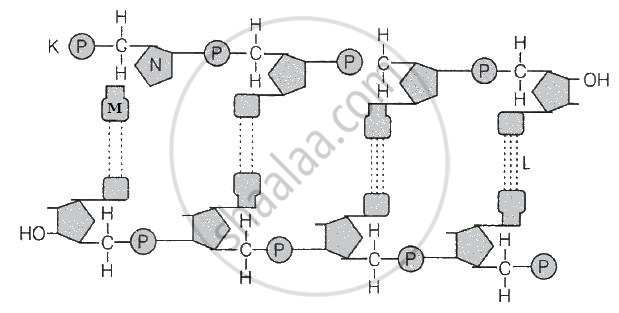Advertisements
Advertisements
Questions
Give scientific reasons:
On complete hydrolysis DNA gives equimolar quantities of adenine and thymine.
Why on complete hydrolysis DNA gives equimolar quantities of adenine and thymine?
Solution
- Both the strands of DNA double helix are complementary to each other.
- That is a number of bases on each strand are equal and complementary to each other.
- As adenine pairs with thymine; the number of adenine bases on one strand and thymine on another are equal in number.
Thus, on complete hydrolysis DNA gives equimolar quantities of adenine and thymine.
RELATED QUESTIONS
Write the sequence of the complementary strand for the following segment of a DNA molecule.
5' - CCGGTTAATACGGC - 3'
Draw a neat diagram for the following:
dAMP
Define the following term.
nucleotide
Draw structure of following.
2-Deoxy-D-ribose
An example of feedback inhibition is ______.
Watson and Crick are known for their discovery of ______.
DNA consists of two complementary nucleotide chains. If the sequence of nucleotide in one of the chains is 5' AGCTTCGA3', then the nucleotide sequence in the other chain shall be ______.
Nucleotides = ____________.
Identify the CORRECT statement.
The pyrimidine bases present in DNA are ____________.
If one strand of the DNA has the sequence ‘ATGCTTGA’, then the sequence of complementary strand would be ____________.
What type of linkages holds together monomers of DNA?
Give any three differences between DNA and RNA.
Write a note on the formation of α-helix.
Complete the flow chart on central dogma.

If Adenine makes 30% of the DNA molecule, what will be the percentage of Thymine, Guanine, and Cytosine in it?
Which of the following are substituted purines?
Draw a neat diagram for the following:
AMP
What type of sugar molecule is present is DNA?
The following ratio is generally constant for a given species
Refer to the given figure.

Select the option which correctly identifies.
Watson and Crick (1953) proposed DNA double helix model and won the Nobel Prize; their model of DNA was based on:
- X-ray diffraction studies of DNA were done by Wilkins and Franklin.
- Chargaff’s base equivalence rule
- Griffith's transformation experiment
- Meselson and Stahl's experiment
Which of the following are correct combination of purine bases?
Write the structure of D-ribose.
Define the Nucleic acids.
